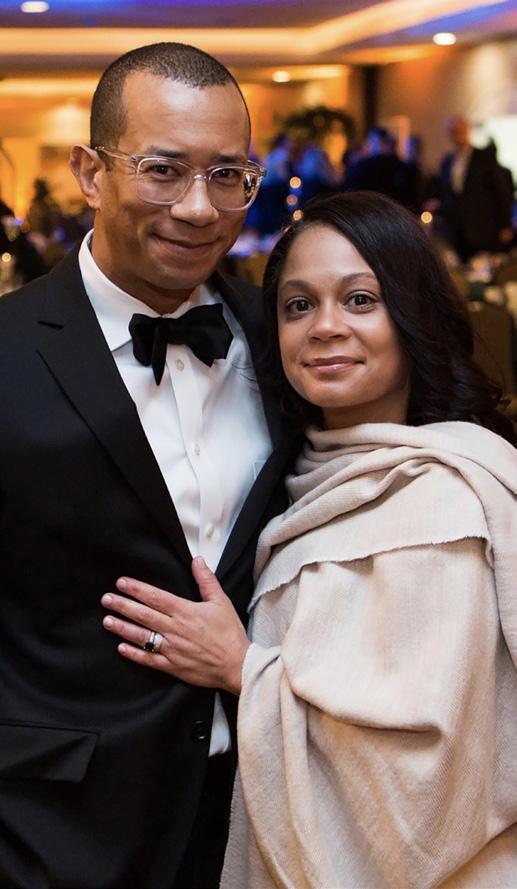
4 minute read
Reaching for Community
PETER JENKINS ’91 and his mother moved from New Rochelle, New York to a farm in the foothills of the Cumberland Mountains when Peter was nine years old. The only child of a single mom, Peter was a city boy in the country. A black kid with a white mom. A northerner in the South.
When Peter was ready for high school, concerned about the quality of the local public schools, his mom suggested boarding school. The minute he stepped onto the St. Andrew’sSewanee campus, Peter knew it was the right place for him. Although it was no longer the school of the Brothers of the Holy Cross, Peter was like many of the boys who had come to St. Andrew’s before him – an Appalachian farm kid without a father in his life. He just happened to be an Appalachian farm kid who had started his life in the suburbs of New York City.
Advertisement

Peter threw himself into life at SAS. He developed a rich network of friends. He ran cross country, wrestled, enjoyed rock climbing, and immersed himself in the arts program, especially ceramics.
He loved the small school setting and the opportunity to get to know his teachers outside of the classroom. When his senior year came, he hoped to continue his education at a college with a similar type of intimate community. He sought a college that would allow him to continue to pursue a well-balanced education that involved academic, arts, athletics, and the outdoors. He was happy to find that, like SAS, Williams College fostered deep connections between students and teachers and valued a well-rounded educational experience.
"Many of my college classmates struggled with their new-found independence," remembers Peter. "Because I had been a boarding student, I was ready for it. I was able to manage the responsibility of balancing academics, athletics, and my social life without an imposed structure.”
At Williams, Peter majored in art and political science, and his interest in ceramics developed into an interest in sculpture. “Art became an important way for me to explore identity. At college, I was able to use my love of creating art to explore the politics of identity and write about community.”
That interest in community included a passion for social justice and a commitment to public service. He returned to SAS in the summers to work as a counselor for a camp that welcomed students from the Bronx and a Lakota reservation. After graduation, he joined Teach for America and taught second and third grade at an inner-city school in Baltimore.
During his three years in Baltimore, Peter was struck by how the health needs of his students affected their academic performance. He started to wonder if the best use of his talents would be to find a way to serve the public thorugh the health professions.
Peter enrolled in a program at Temple University that prepared him for medical school. He was accepted to the Perelman School of Medicine at the University of Pennsylvania, one of the top medical schools in the world and entered medical school intending to become a pediatrician.
After 11 years studying, interning, and working in Philadelphia hospitals, Peter pursued further training in research at the University of Michigan as a Robert Wood Johnson Clinical Scholar. He is now an Assistant Professor of Surgery at Indiana University in Indianapolis. He balances his time between caring for trauma patients and working with the Indiana Department of Health to examine and improve the healthcare outcomes of critically injured patients.

His work supports his social justice interests. While trauma cuts across communities, it disproportionately affects those who are socioeconomically disadvantaged. “We invest a lot of resources at designated trauma centers, but the majority of patients are initially treated at rural hospitals. I am looking for ways to provide support to hospitals that are systematically neglected.”
Peter has found ways to provide his six-year-old son with some of the experiences he valued at SAS. He, his wife, and child live on an acre of land in the middle of the woods but in a neighborhood they sought out for its diversity. His son attends a small school that is connected to the land and offers opportunity for creative expression and athletics. Rock climbing and gardening are important family activities and provide Peter with an opportunity to relax after a stressful day.
By example, he is showing his son the importance of community service, not just in his workday, but as a member of the alumni board of Teach for America. “I look for opportunities to teach my son to practice decency and grace. I share my feelings with him honestly about my work and why it’s important to me. We look for opportunities to incorporate service in his life.”
"My mother explicitly and implicitly committed to raising me in a way that valued community and responsibility,” Peter explains. “That was one of the many lessons I learned on the farm. I hauled rocks to build the foundation of my neighbor’s house. We looked out for each other and had a responsibility to our community and a sense of service.” Those values were reinforced as a boarder at SAS.
Like a rock climber setting his course, each step in Peter’s life has opened up new opportunities for reaching a little farther and higher. Ceramics provided the foothold that took him to sculpture, which led him to become a surgeon. A childhood in the outdoors gave Peter a solid base for finding a continuous joy and peace in nature that he now passes on to his son. And, experiences in caring communities led him to find new communities needing his care.






